Investigating the Digital Economy's Impact on E-commerce in Malaysia
VerifiedAdded on 2023/06/10
|102
|17600
|284
Report
AI Summary
This report investigates the influences of the digital economy on the development of e-commerce in Malaysia. It begins by highlighting the importance of IT and its impact on businesses and consumers, noting the Malaysian government's focus on developing a knowledge-based economy. The study explores factors such as technology adaptability, internet knowledge, trust, and accessibility of technology, and how these variables impact e-commerce growth. The research methodology includes a survey-based approach with descriptive and correlation analysis. The report presents findings on the respondents' familiarity with technology, their trust in e-commerce, and the accessibility of technology in their areas. The study concludes with recommendations for further enhancing e-commerce adoption and addresses limitations and future research scopes. This document is available on Desklib, a platform offering study tools and resources for students.
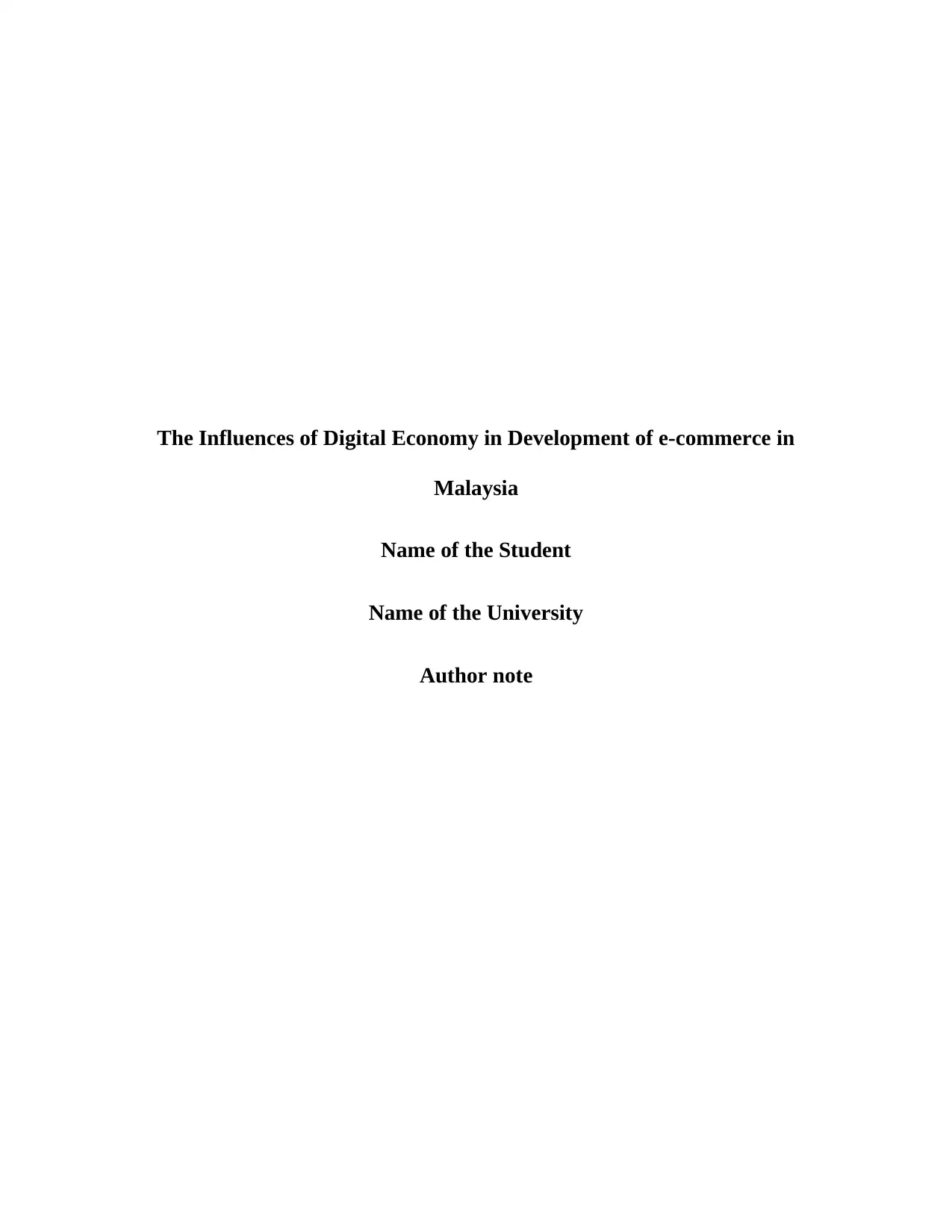
The Influences of Digital Economy in Development of e-commerce in
Malaysia
Name of the Student
Name of the University
Author note
Malaysia
Name of the Student
Name of the University
Author note
Paraphrase This Document
Need a fresh take? Get an instant paraphrase of this document with our AI Paraphraser
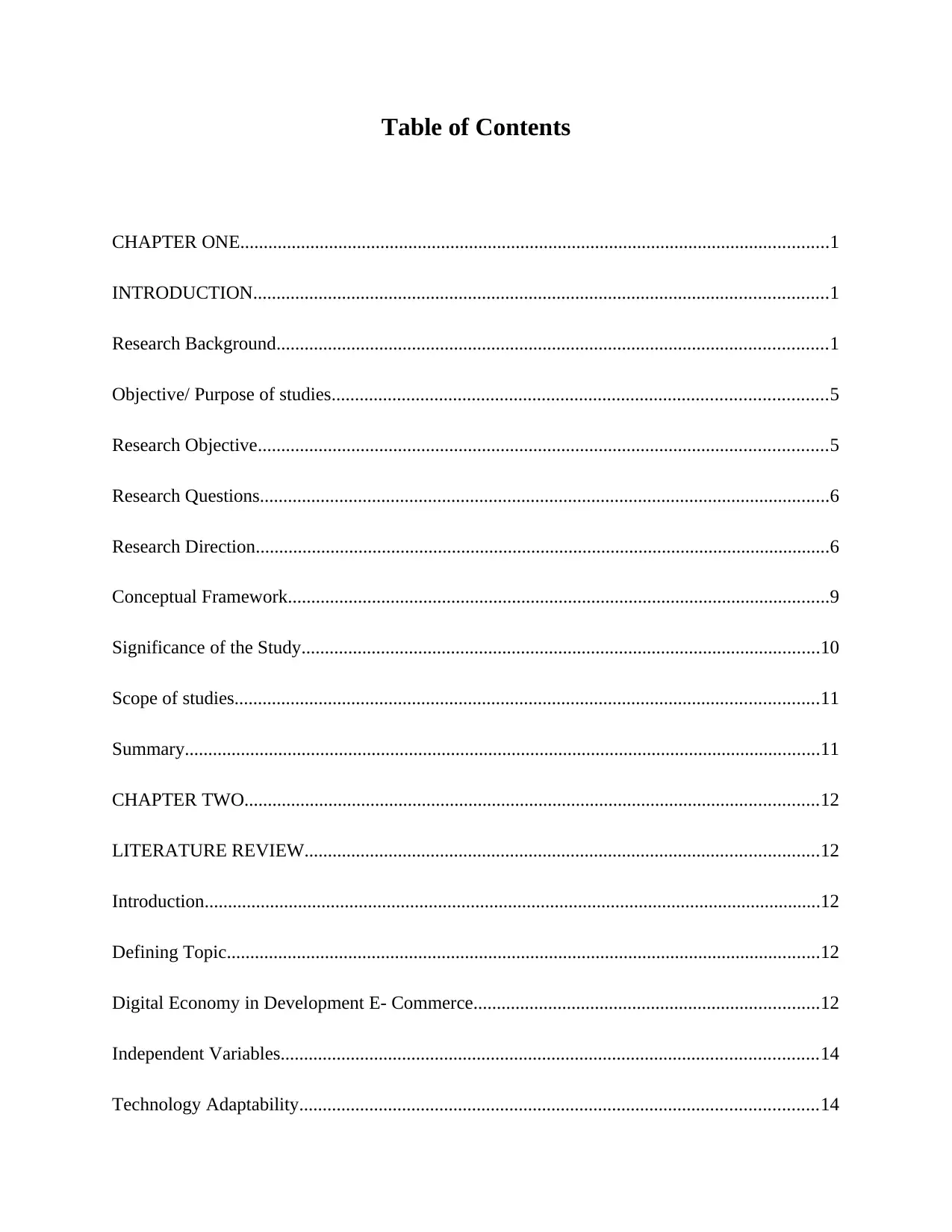
Table of Contents
CHAPTER ONE..............................................................................................................................1
INTRODUCTION...........................................................................................................................1
Research Background......................................................................................................................1
Objective/ Purpose of studies..........................................................................................................5
Research Objective..........................................................................................................................5
Research Questions..........................................................................................................................6
Research Direction...........................................................................................................................6
Conceptual Framework....................................................................................................................9
Significance of the Study...............................................................................................................10
Scope of studies.............................................................................................................................11
Summary........................................................................................................................................11
CHAPTER TWO...........................................................................................................................12
LITERATURE REVIEW..............................................................................................................12
Introduction....................................................................................................................................12
Defining Topic...............................................................................................................................12
Digital Economy in Development E- Commerce..........................................................................12
Independent Variables...................................................................................................................14
Technology Adaptability...............................................................................................................14
CHAPTER ONE..............................................................................................................................1
INTRODUCTION...........................................................................................................................1
Research Background......................................................................................................................1
Objective/ Purpose of studies..........................................................................................................5
Research Objective..........................................................................................................................5
Research Questions..........................................................................................................................6
Research Direction...........................................................................................................................6
Conceptual Framework....................................................................................................................9
Significance of the Study...............................................................................................................10
Scope of studies.............................................................................................................................11
Summary........................................................................................................................................11
CHAPTER TWO...........................................................................................................................12
LITERATURE REVIEW..............................................................................................................12
Introduction....................................................................................................................................12
Defining Topic...............................................................................................................................12
Digital Economy in Development E- Commerce..........................................................................12
Independent Variables...................................................................................................................14
Technology Adaptability...............................................................................................................14
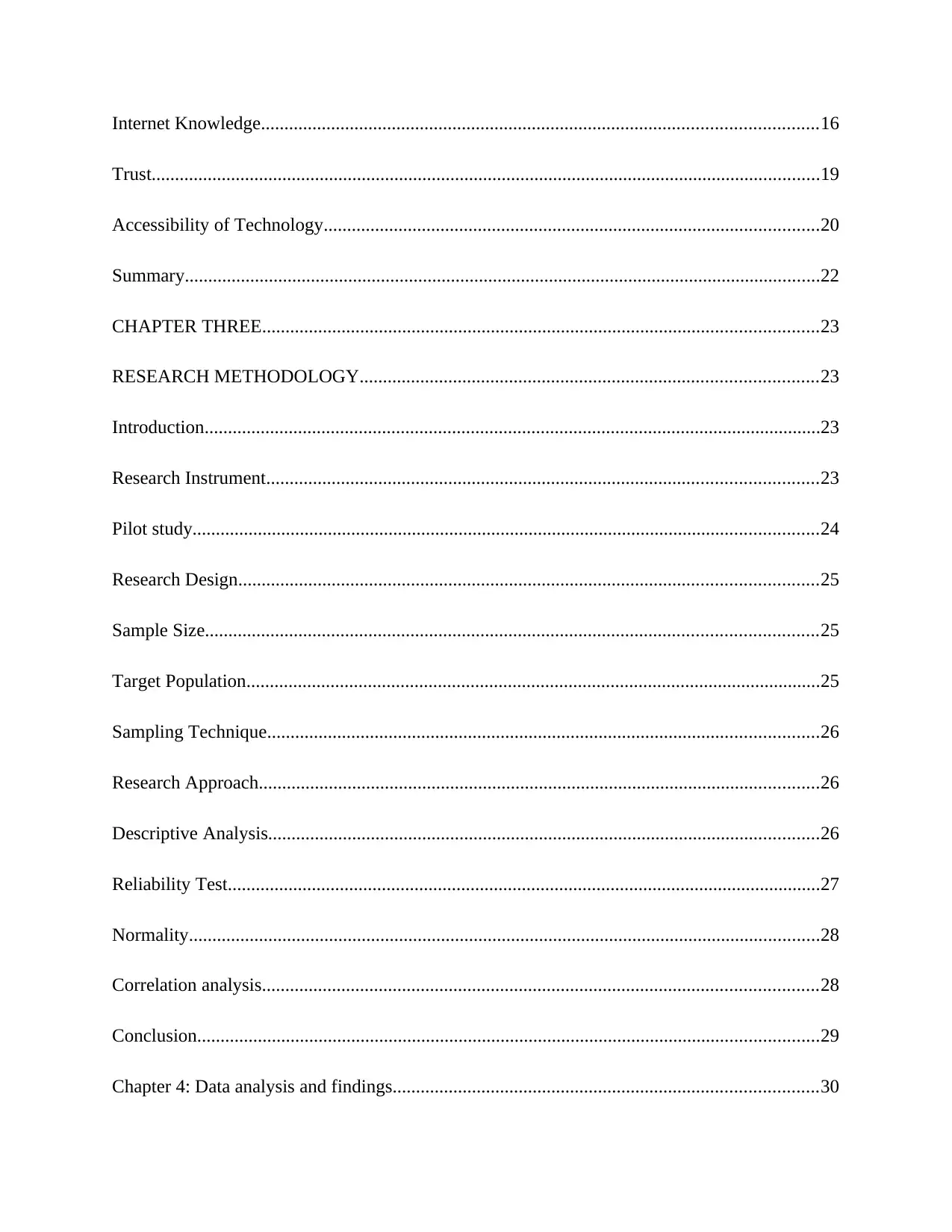
Internet Knowledge.......................................................................................................................16
Trust...............................................................................................................................................19
Accessibility of Technology..........................................................................................................20
Summary........................................................................................................................................22
CHAPTER THREE.......................................................................................................................23
RESEARCH METHODOLOGY..................................................................................................23
Introduction....................................................................................................................................23
Research Instrument......................................................................................................................23
Pilot study......................................................................................................................................24
Research Design............................................................................................................................25
Sample Size...................................................................................................................................25
Target Population...........................................................................................................................25
Sampling Technique......................................................................................................................26
Research Approach........................................................................................................................26
Descriptive Analysis......................................................................................................................26
Reliability Test...............................................................................................................................27
Normality.......................................................................................................................................28
Correlation analysis.......................................................................................................................28
Conclusion.....................................................................................................................................29
Chapter 4: Data analysis and findings...........................................................................................30
Trust...............................................................................................................................................19
Accessibility of Technology..........................................................................................................20
Summary........................................................................................................................................22
CHAPTER THREE.......................................................................................................................23
RESEARCH METHODOLOGY..................................................................................................23
Introduction....................................................................................................................................23
Research Instrument......................................................................................................................23
Pilot study......................................................................................................................................24
Research Design............................................................................................................................25
Sample Size...................................................................................................................................25
Target Population...........................................................................................................................25
Sampling Technique......................................................................................................................26
Research Approach........................................................................................................................26
Descriptive Analysis......................................................................................................................26
Reliability Test...............................................................................................................................27
Normality.......................................................................................................................................28
Correlation analysis.......................................................................................................................28
Conclusion.....................................................................................................................................29
Chapter 4: Data analysis and findings...........................................................................................30
⊘ This is a preview!⊘
Do you want full access?
Subscribe today to unlock all pages.

Trusted by 1+ million students worldwide
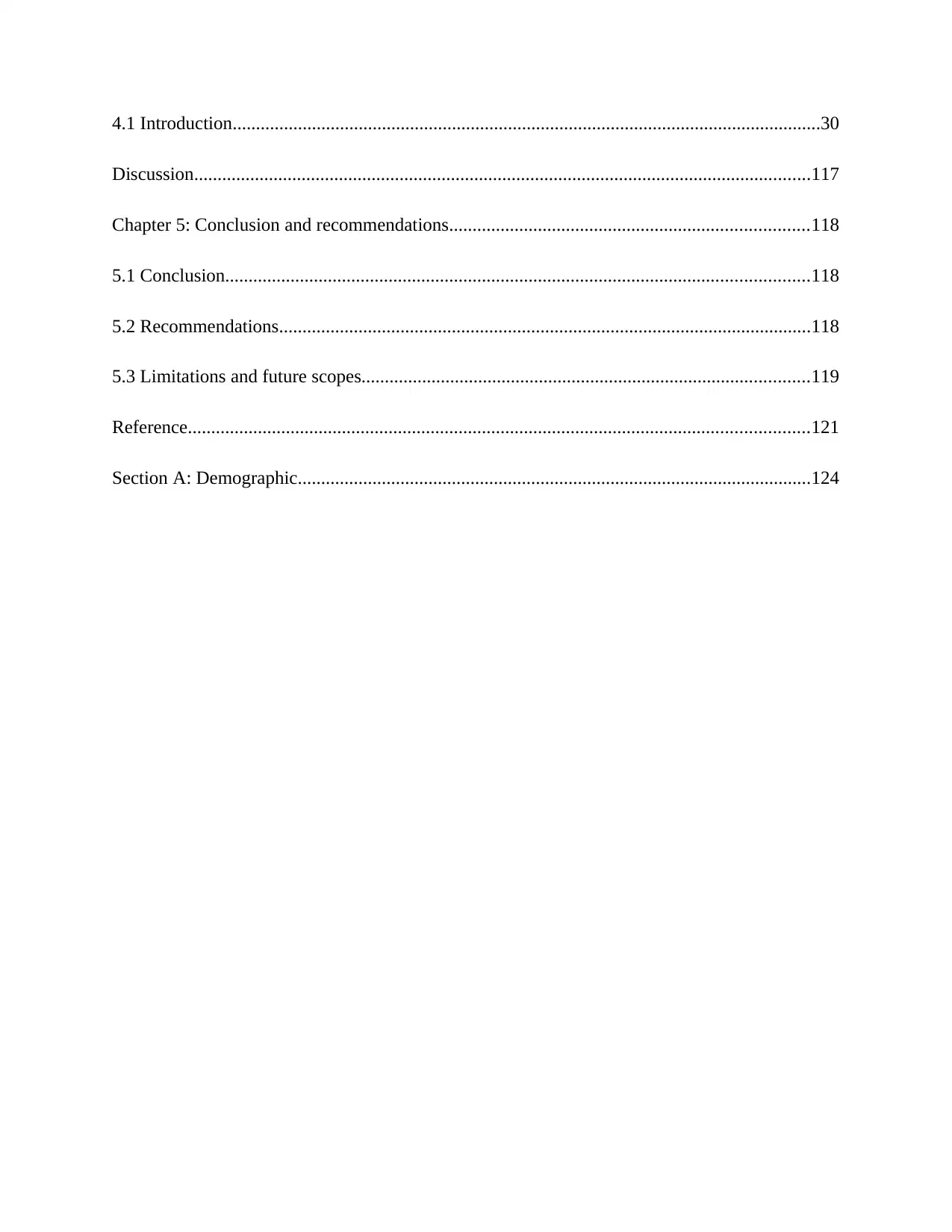
4.1 Introduction..............................................................................................................................30
Discussion....................................................................................................................................117
Chapter 5: Conclusion and recommendations.............................................................................118
5.1 Conclusion.............................................................................................................................118
5.2 Recommendations..................................................................................................................118
5.3 Limitations and future scopes................................................................................................119
Reference.....................................................................................................................................121
Section A: Demographic..............................................................................................................124
Discussion....................................................................................................................................117
Chapter 5: Conclusion and recommendations.............................................................................118
5.1 Conclusion.............................................................................................................................118
5.2 Recommendations..................................................................................................................118
5.3 Limitations and future scopes................................................................................................119
Reference.....................................................................................................................................121
Section A: Demographic..............................................................................................................124
Paraphrase This Document
Need a fresh take? Get an instant paraphrase of this document with our AI Paraphraser
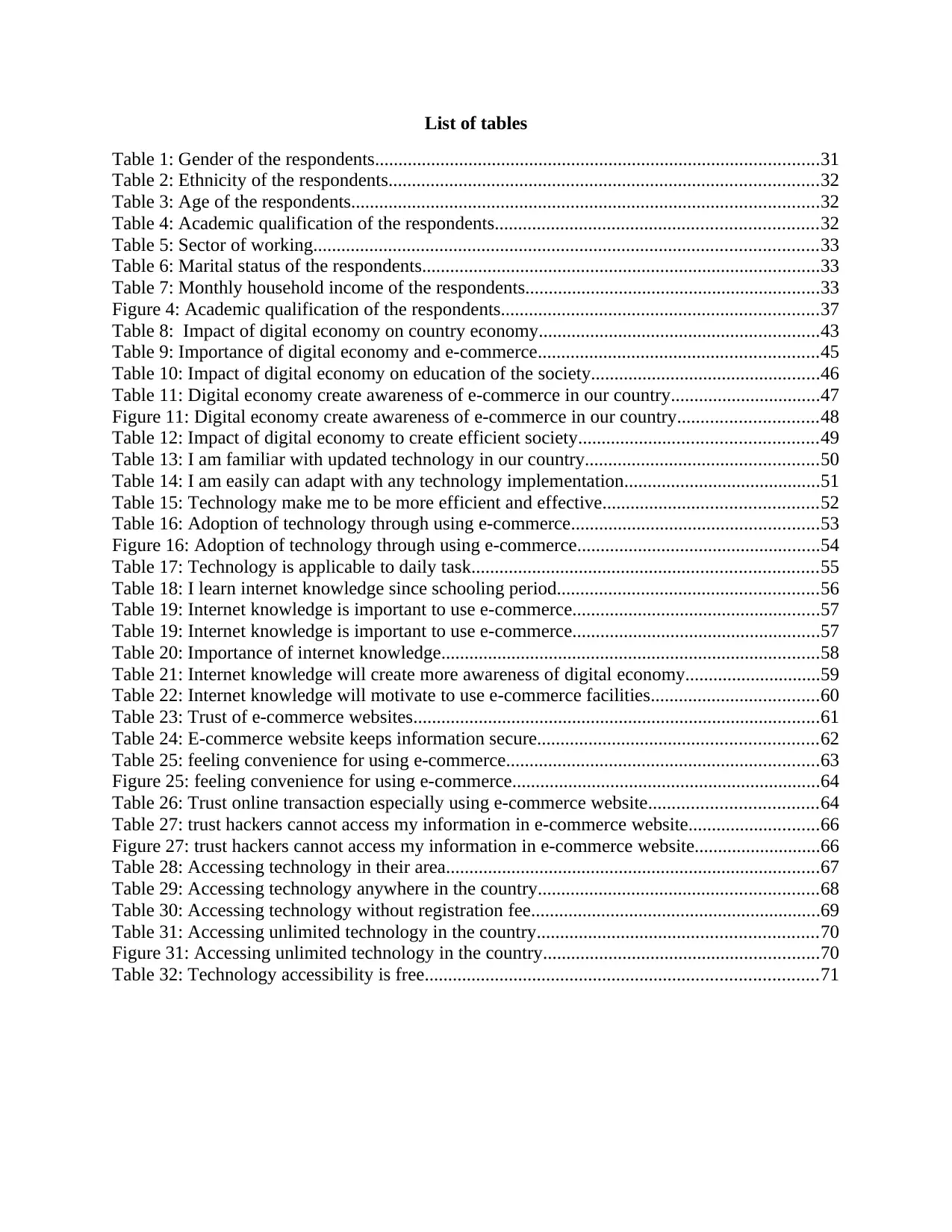
List of tables
Table 1: Gender of the respondents...............................................................................................31
Table 2: Ethnicity of the respondents............................................................................................32
Table 3: Age of the respondents....................................................................................................32
Table 4: Academic qualification of the respondents.....................................................................32
Table 5: Sector of working............................................................................................................33
Table 6: Marital status of the respondents.....................................................................................33
Table 7: Monthly household income of the respondents...............................................................33
Figure 4: Academic qualification of the respondents....................................................................37
Table 8: Impact of digital economy on country economy............................................................43
Table 9: Importance of digital economy and e-commerce............................................................45
Table 10: Impact of digital economy on education of the society.................................................46
Table 11: Digital economy create awareness of e-commerce in our country................................47
Figure 11: Digital economy create awareness of e-commerce in our country..............................48
Table 12: Impact of digital economy to create efficient society...................................................49
Table 13: I am familiar with updated technology in our country..................................................50
Table 14: I am easily can adapt with any technology implementation..........................................51
Table 15: Technology make me to be more efficient and effective..............................................52
Table 16: Adoption of technology through using e-commerce.....................................................53
Figure 16: Adoption of technology through using e-commerce....................................................54
Table 17: Technology is applicable to daily task..........................................................................55
Table 18: I learn internet knowledge since schooling period........................................................56
Table 19: Internet knowledge is important to use e-commerce.....................................................57
Table 19: Internet knowledge is important to use e-commerce.....................................................57
Table 20: Importance of internet knowledge.................................................................................58
Table 21: Internet knowledge will create more awareness of digital economy.............................59
Table 22: Internet knowledge will motivate to use e-commerce facilities....................................60
Table 23: Trust of e-commerce websites.......................................................................................61
Table 24: E-commerce website keeps information secure............................................................62
Table 25: feeling convenience for using e-commerce...................................................................63
Figure 25: feeling convenience for using e-commerce..................................................................64
Table 26: Trust online transaction especially using e-commerce website....................................64
Table 27: trust hackers cannot access my information in e-commerce website............................66
Figure 27: trust hackers cannot access my information in e-commerce website...........................66
Table 28: Accessing technology in their area................................................................................67
Table 29: Accessing technology anywhere in the country............................................................68
Table 30: Accessing technology without registration fee..............................................................69
Table 31: Accessing unlimited technology in the country............................................................70
Figure 31: Accessing unlimited technology in the country...........................................................70
Table 32: Technology accessibility is free....................................................................................71
Table 1: Gender of the respondents...............................................................................................31
Table 2: Ethnicity of the respondents............................................................................................32
Table 3: Age of the respondents....................................................................................................32
Table 4: Academic qualification of the respondents.....................................................................32
Table 5: Sector of working............................................................................................................33
Table 6: Marital status of the respondents.....................................................................................33
Table 7: Monthly household income of the respondents...............................................................33
Figure 4: Academic qualification of the respondents....................................................................37
Table 8: Impact of digital economy on country economy............................................................43
Table 9: Importance of digital economy and e-commerce............................................................45
Table 10: Impact of digital economy on education of the society.................................................46
Table 11: Digital economy create awareness of e-commerce in our country................................47
Figure 11: Digital economy create awareness of e-commerce in our country..............................48
Table 12: Impact of digital economy to create efficient society...................................................49
Table 13: I am familiar with updated technology in our country..................................................50
Table 14: I am easily can adapt with any technology implementation..........................................51
Table 15: Technology make me to be more efficient and effective..............................................52
Table 16: Adoption of technology through using e-commerce.....................................................53
Figure 16: Adoption of technology through using e-commerce....................................................54
Table 17: Technology is applicable to daily task..........................................................................55
Table 18: I learn internet knowledge since schooling period........................................................56
Table 19: Internet knowledge is important to use e-commerce.....................................................57
Table 19: Internet knowledge is important to use e-commerce.....................................................57
Table 20: Importance of internet knowledge.................................................................................58
Table 21: Internet knowledge will create more awareness of digital economy.............................59
Table 22: Internet knowledge will motivate to use e-commerce facilities....................................60
Table 23: Trust of e-commerce websites.......................................................................................61
Table 24: E-commerce website keeps information secure............................................................62
Table 25: feeling convenience for using e-commerce...................................................................63
Figure 25: feeling convenience for using e-commerce..................................................................64
Table 26: Trust online transaction especially using e-commerce website....................................64
Table 27: trust hackers cannot access my information in e-commerce website............................66
Figure 27: trust hackers cannot access my information in e-commerce website...........................66
Table 28: Accessing technology in their area................................................................................67
Table 29: Accessing technology anywhere in the country............................................................68
Table 30: Accessing technology without registration fee..............................................................69
Table 31: Accessing unlimited technology in the country............................................................70
Figure 31: Accessing unlimited technology in the country...........................................................70
Table 32: Technology accessibility is free....................................................................................71
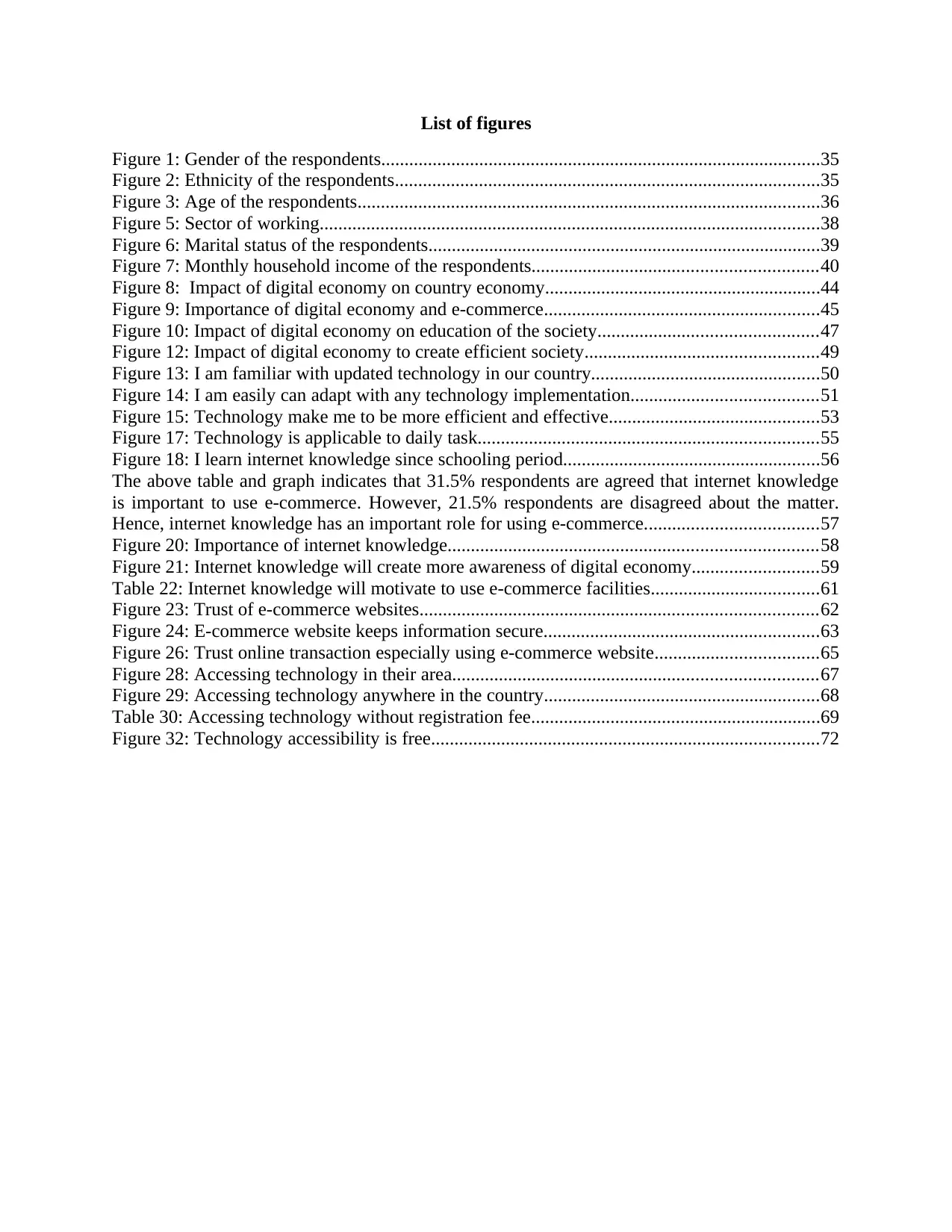
List of figures
Figure 1: Gender of the respondents..............................................................................................35
Figure 2: Ethnicity of the respondents...........................................................................................35
Figure 3: Age of the respondents...................................................................................................36
Figure 5: Sector of working...........................................................................................................38
Figure 6: Marital status of the respondents....................................................................................39
Figure 7: Monthly household income of the respondents.............................................................40
Figure 8: Impact of digital economy on country economy...........................................................44
Figure 9: Importance of digital economy and e-commerce...........................................................45
Figure 10: Impact of digital economy on education of the society...............................................47
Figure 12: Impact of digital economy to create efficient society..................................................49
Figure 13: I am familiar with updated technology in our country.................................................50
Figure 14: I am easily can adapt with any technology implementation........................................51
Figure 15: Technology make me to be more efficient and effective.............................................53
Figure 17: Technology is applicable to daily task.........................................................................55
Figure 18: I learn internet knowledge since schooling period.......................................................56
The above table and graph indicates that 31.5% respondents are agreed that internet knowledge
is important to use e-commerce. However, 21.5% respondents are disagreed about the matter.
Hence, internet knowledge has an important role for using e-commerce.....................................57
Figure 20: Importance of internet knowledge...............................................................................58
Figure 21: Internet knowledge will create more awareness of digital economy...........................59
Table 22: Internet knowledge will motivate to use e-commerce facilities....................................61
Figure 23: Trust of e-commerce websites.....................................................................................62
Figure 24: E-commerce website keeps information secure...........................................................63
Figure 26: Trust online transaction especially using e-commerce website...................................65
Figure 28: Accessing technology in their area..............................................................................67
Figure 29: Accessing technology anywhere in the country...........................................................68
Table 30: Accessing technology without registration fee..............................................................69
Figure 32: Technology accessibility is free...................................................................................72
Figure 1: Gender of the respondents..............................................................................................35
Figure 2: Ethnicity of the respondents...........................................................................................35
Figure 3: Age of the respondents...................................................................................................36
Figure 5: Sector of working...........................................................................................................38
Figure 6: Marital status of the respondents....................................................................................39
Figure 7: Monthly household income of the respondents.............................................................40
Figure 8: Impact of digital economy on country economy...........................................................44
Figure 9: Importance of digital economy and e-commerce...........................................................45
Figure 10: Impact of digital economy on education of the society...............................................47
Figure 12: Impact of digital economy to create efficient society..................................................49
Figure 13: I am familiar with updated technology in our country.................................................50
Figure 14: I am easily can adapt with any technology implementation........................................51
Figure 15: Technology make me to be more efficient and effective.............................................53
Figure 17: Technology is applicable to daily task.........................................................................55
Figure 18: I learn internet knowledge since schooling period.......................................................56
The above table and graph indicates that 31.5% respondents are agreed that internet knowledge
is important to use e-commerce. However, 21.5% respondents are disagreed about the matter.
Hence, internet knowledge has an important role for using e-commerce.....................................57
Figure 20: Importance of internet knowledge...............................................................................58
Figure 21: Internet knowledge will create more awareness of digital economy...........................59
Table 22: Internet knowledge will motivate to use e-commerce facilities....................................61
Figure 23: Trust of e-commerce websites.....................................................................................62
Figure 24: E-commerce website keeps information secure...........................................................63
Figure 26: Trust online transaction especially using e-commerce website...................................65
Figure 28: Accessing technology in their area..............................................................................67
Figure 29: Accessing technology anywhere in the country...........................................................68
Table 30: Accessing technology without registration fee..............................................................69
Figure 32: Technology accessibility is free...................................................................................72
⊘ This is a preview!⊘
Do you want full access?
Subscribe today to unlock all pages.

Trusted by 1+ million students worldwide
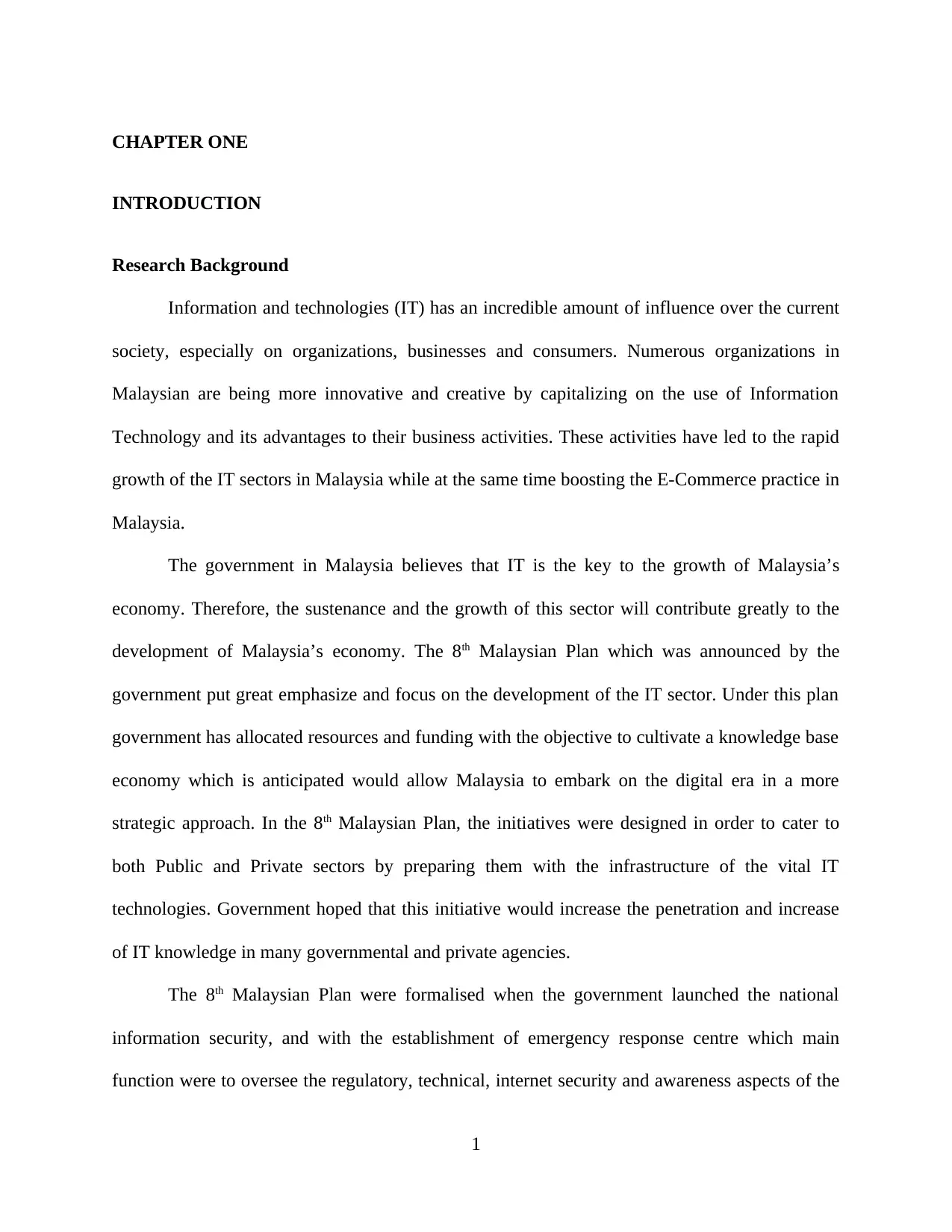
CHAPTER ONE
INTRODUCTION
Research Background
Information and technologies (IT) has an incredible amount of influence over the current
society, especially on organizations, businesses and consumers. Numerous organizations in
Malaysian are being more innovative and creative by capitalizing on the use of Information
Technology and its advantages to their business activities. These activities have led to the rapid
growth of the IT sectors in Malaysia while at the same time boosting the E-Commerce practice in
Malaysia.
The government in Malaysia believes that IT is the key to the growth of Malaysia’s
economy. Therefore, the sustenance and the growth of this sector will contribute greatly to the
development of Malaysia’s economy. The 8th Malaysian Plan which was announced by the
government put great emphasize and focus on the development of the IT sector. Under this plan
government has allocated resources and funding with the objective to cultivate a knowledge base
economy which is anticipated would allow Malaysia to embark on the digital era in a more
strategic approach. In the 8th Malaysian Plan, the initiatives were designed in order to cater to
both Public and Private sectors by preparing them with the infrastructure of the vital IT
technologies. Government hoped that this initiative would increase the penetration and increase
of IT knowledge in many governmental and private agencies.
The 8th Malaysian Plan were formalised when the government launched the national
information security, and with the establishment of emergency response centre which main
function were to oversee the regulatory, technical, internet security and awareness aspects of the
1
INTRODUCTION
Research Background
Information and technologies (IT) has an incredible amount of influence over the current
society, especially on organizations, businesses and consumers. Numerous organizations in
Malaysian are being more innovative and creative by capitalizing on the use of Information
Technology and its advantages to their business activities. These activities have led to the rapid
growth of the IT sectors in Malaysia while at the same time boosting the E-Commerce practice in
Malaysia.
The government in Malaysia believes that IT is the key to the growth of Malaysia’s
economy. Therefore, the sustenance and the growth of this sector will contribute greatly to the
development of Malaysia’s economy. The 8th Malaysian Plan which was announced by the
government put great emphasize and focus on the development of the IT sector. Under this plan
government has allocated resources and funding with the objective to cultivate a knowledge base
economy which is anticipated would allow Malaysia to embark on the digital era in a more
strategic approach. In the 8th Malaysian Plan, the initiatives were designed in order to cater to
both Public and Private sectors by preparing them with the infrastructure of the vital IT
technologies. Government hoped that this initiative would increase the penetration and increase
of IT knowledge in many governmental and private agencies.
The 8th Malaysian Plan were formalised when the government launched the national
information security, and with the establishment of emergency response centre which main
function were to oversee the regulatory, technical, internet security and awareness aspects of the
1
Paraphrase This Document
Need a fresh take? Get an instant paraphrase of this document with our AI Paraphraser
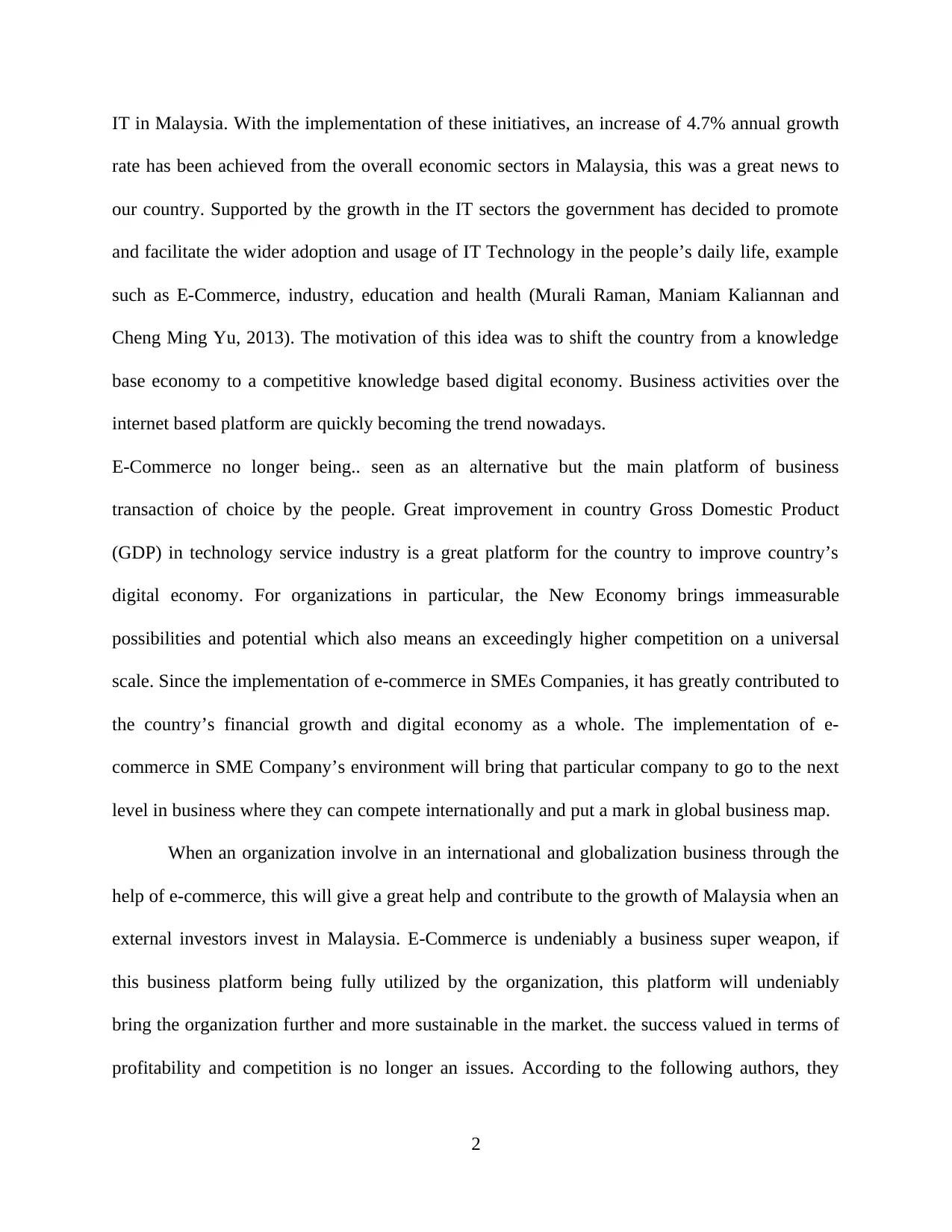
IT in Malaysia. With the implementation of these initiatives, an increase of 4.7% annual growth
rate has been achieved from the overall economic sectors in Malaysia, this was a great news to
our country. Supported by the growth in the IT sectors the government has decided to promote
and facilitate the wider adoption and usage of IT Technology in the people’s daily life, example
such as E-Commerce, industry, education and health (Murali Raman, Maniam Kaliannan and
Cheng Ming Yu, 2013). The motivation of this idea was to shift the country from a knowledge
base economy to a competitive knowledge based digital economy. Business activities over the
internet based platform are quickly becoming the trend nowadays.
E-Commerce no longer being.. seen as an alternative but the main platform of business
transaction of choice by the people. Great improvement in country Gross Domestic Product
(GDP) in technology service industry is a great platform for the country to improve country’s
digital economy. For organizations in particular, the New Economy brings immeasurable
possibilities and potential which also means an exceedingly higher competition on a universal
scale. Since the implementation of e-commerce in SMEs Companies, it has greatly contributed to
the country’s financial growth and digital economy as a whole. The implementation of e-
commerce in SME Company’s environment will bring that particular company to go to the next
level in business where they can compete internationally and put a mark in global business map.
When an organization involve in an international and globalization business through the
help of e-commerce, this will give a great help and contribute to the growth of Malaysia when an
external investors invest in Malaysia. E-Commerce is undeniably a business super weapon, if
this business platform being fully utilized by the organization, this platform will undeniably
bring the organization further and more sustainable in the market. the success valued in terms of
profitability and competition is no longer an issues. According to the following authors, they
2
rate has been achieved from the overall economic sectors in Malaysia, this was a great news to
our country. Supported by the growth in the IT sectors the government has decided to promote
and facilitate the wider adoption and usage of IT Technology in the people’s daily life, example
such as E-Commerce, industry, education and health (Murali Raman, Maniam Kaliannan and
Cheng Ming Yu, 2013). The motivation of this idea was to shift the country from a knowledge
base economy to a competitive knowledge based digital economy. Business activities over the
internet based platform are quickly becoming the trend nowadays.
E-Commerce no longer being.. seen as an alternative but the main platform of business
transaction of choice by the people. Great improvement in country Gross Domestic Product
(GDP) in technology service industry is a great platform for the country to improve country’s
digital economy. For organizations in particular, the New Economy brings immeasurable
possibilities and potential which also means an exceedingly higher competition on a universal
scale. Since the implementation of e-commerce in SMEs Companies, it has greatly contributed to
the country’s financial growth and digital economy as a whole. The implementation of e-
commerce in SME Company’s environment will bring that particular company to go to the next
level in business where they can compete internationally and put a mark in global business map.
When an organization involve in an international and globalization business through the
help of e-commerce, this will give a great help and contribute to the growth of Malaysia when an
external investors invest in Malaysia. E-Commerce is undeniably a business super weapon, if
this business platform being fully utilized by the organization, this platform will undeniably
bring the organization further and more sustainable in the market. the success valued in terms of
profitability and competition is no longer an issues. According to the following authors, they
2
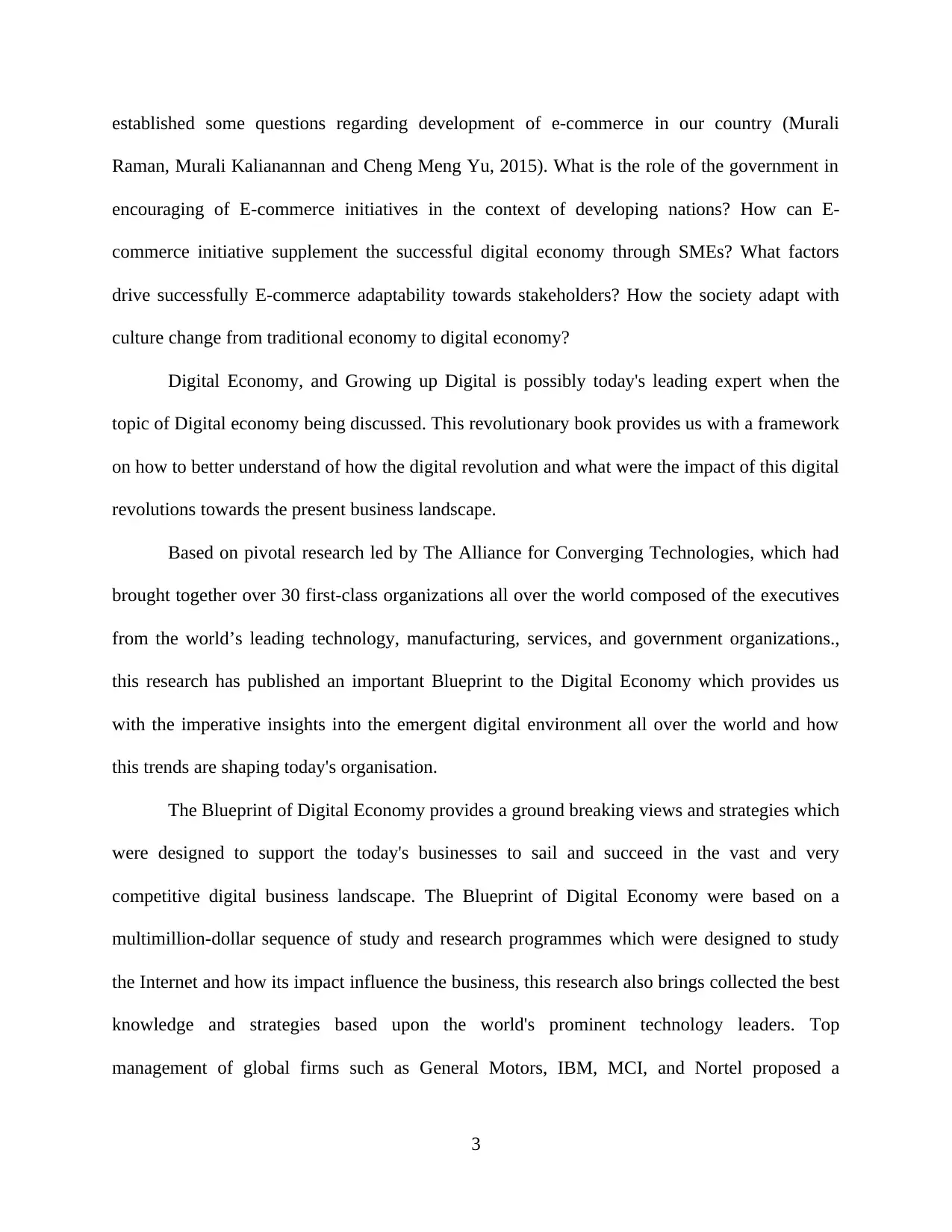
established some questions regarding development of e-commerce in our country (Murali
Raman, Murali Kalianannan and Cheng Meng Yu, 2015). What is the role of the government in
encouraging of E-commerce initiatives in the context of developing nations? How can E-
commerce initiative supplement the successful digital economy through SMEs? What factors
drive successfully E-commerce adaptability towards stakeholders? How the society adapt with
culture change from traditional economy to digital economy?
Digital Economy, and Growing up Digital is possibly today's leading expert when the
topic of Digital economy being discussed. This revolutionary book provides us with a framework
on how to better understand of how the digital revolution and what were the impact of this digital
revolutions towards the present business landscape.
Based on pivotal research led by The Alliance for Converging Technologies, which had
brought together over 30 first-class organizations all over the world composed of the executives
from the world’s leading technology, manufacturing, services, and government organizations.,
this research has published an important Blueprint to the Digital Economy which provides us
with the imperative insights into the emergent digital environment all over the world and how
this trends are shaping today's organisation.
The Blueprint of Digital Economy provides a ground breaking views and strategies which
were designed to support the today's businesses to sail and succeed in the vast and very
competitive digital business landscape. The Blueprint of Digital Economy were based on a
multimillion-dollar sequence of study and research programmes which were designed to study
the Internet and how its impact influence the business, this research also brings collected the best
knowledge and strategies based upon the world's prominent technology leaders. Top
management of global firms such as General Motors, IBM, MCI, and Nortel proposed a
3
Raman, Murali Kalianannan and Cheng Meng Yu, 2015). What is the role of the government in
encouraging of E-commerce initiatives in the context of developing nations? How can E-
commerce initiative supplement the successful digital economy through SMEs? What factors
drive successfully E-commerce adaptability towards stakeholders? How the society adapt with
culture change from traditional economy to digital economy?
Digital Economy, and Growing up Digital is possibly today's leading expert when the
topic of Digital economy being discussed. This revolutionary book provides us with a framework
on how to better understand of how the digital revolution and what were the impact of this digital
revolutions towards the present business landscape.
Based on pivotal research led by The Alliance for Converging Technologies, which had
brought together over 30 first-class organizations all over the world composed of the executives
from the world’s leading technology, manufacturing, services, and government organizations.,
this research has published an important Blueprint to the Digital Economy which provides us
with the imperative insights into the emergent digital environment all over the world and how
this trends are shaping today's organisation.
The Blueprint of Digital Economy provides a ground breaking views and strategies which
were designed to support the today's businesses to sail and succeed in the vast and very
competitive digital business landscape. The Blueprint of Digital Economy were based on a
multimillion-dollar sequence of study and research programmes which were designed to study
the Internet and how its impact influence the business, this research also brings collected the best
knowledge and strategies based upon the world's prominent technology leaders. Top
management of global firms such as General Motors, IBM, MCI, and Nortel proposed a
3
⊘ This is a preview!⊘
Do you want full access?
Subscribe today to unlock all pages.

Trusted by 1+ million students worldwide

stimulating illustrations and examples on how their businesses will use emergent networking and
multimedia technologies in order to bring a change to the competitive risks in their respective
industries. Blueprint of the Digital Economy brings a combined fortune of knowledge and
experience of top people in the industry with main purpose it to help businesses to realise digital
promise into a reality (Don Tapscott, 2009).
The shift of economy towards digital economy in today’s world has changed today’s
business landscape and this changes has produced a different forms of organizations which
capitalizes on the usage of IT to improve the knowledge and maximize the organizational
efficiency and effectiveness as a whole. Nevertheless, the more isolated concerns will be shifting
the organizational goals and objectives. Transformational not only happened in organizational
level, but e-commerce adaption is must to organizational level customers, suppliers, employees
and other stakeholders. For examples: when consumer want to improve his or hers learning
efficiency and effectiveness by using IT tools on their own computer or digital devices; the top
performer group where a group of employees within the same company work together
effectively by means of digitals tools to change the present job design to latest technology; the
incorporated firm: when an employees in an brought together in teams to do projects using the IT
technologies, it results in an inclusive structural change; - the incorporated firm: is a firm that has
a well-established connection and networks with its customers and providers which lead to the
creation of value chain.
In this approach products and/or services can be personalized and distributed within a
short period. This effects in shifting the current external relations and reshape the new
boundaries and expectations; - the internetworked business: where a company connect with the
other businesses on an exceptionally flexible basis through a 'virtual' connection or digital form,
4
multimedia technologies in order to bring a change to the competitive risks in their respective
industries. Blueprint of the Digital Economy brings a combined fortune of knowledge and
experience of top people in the industry with main purpose it to help businesses to realise digital
promise into a reality (Don Tapscott, 2009).
The shift of economy towards digital economy in today’s world has changed today’s
business landscape and this changes has produced a different forms of organizations which
capitalizes on the usage of IT to improve the knowledge and maximize the organizational
efficiency and effectiveness as a whole. Nevertheless, the more isolated concerns will be shifting
the organizational goals and objectives. Transformational not only happened in organizational
level, but e-commerce adaption is must to organizational level customers, suppliers, employees
and other stakeholders. For examples: when consumer want to improve his or hers learning
efficiency and effectiveness by using IT tools on their own computer or digital devices; the top
performer group where a group of employees within the same company work together
effectively by means of digitals tools to change the present job design to latest technology; the
incorporated firm: when an employees in an brought together in teams to do projects using the IT
technologies, it results in an inclusive structural change; - the incorporated firm: is a firm that has
a well-established connection and networks with its customers and providers which lead to the
creation of value chain.
In this approach products and/or services can be personalized and distributed within a
short period. This effects in shifting the current external relations and reshape the new
boundaries and expectations; - the internetworked business: where a company connect with the
other businesses on an exceptionally flexible basis through a 'virtual' connection or digital form,
4
Paraphrase This Document
Need a fresh take? Get an instant paraphrase of this document with our AI Paraphraser
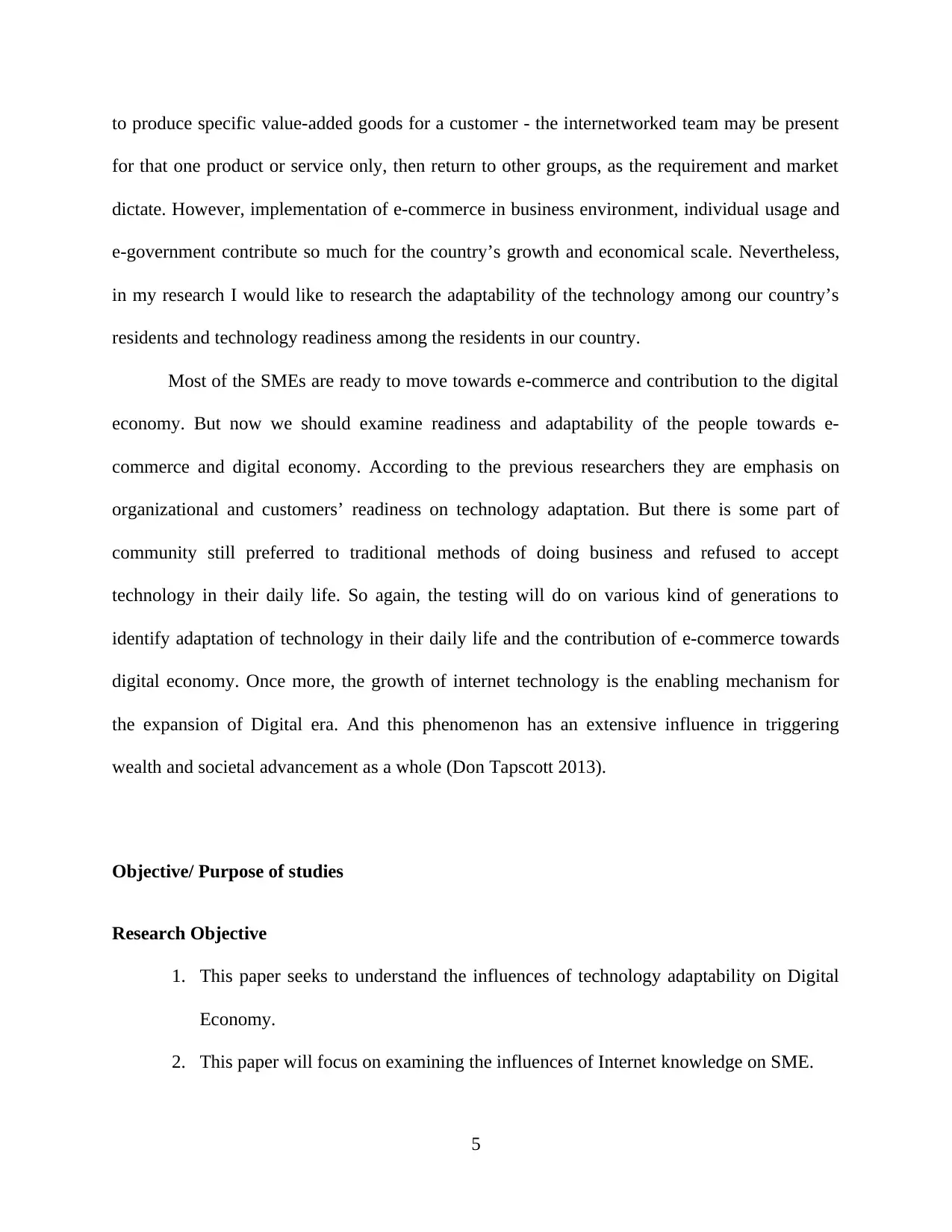
to produce specific value-added goods for a customer - the internetworked team may be present
for that one product or service only, then return to other groups, as the requirement and market
dictate. However, implementation of e-commerce in business environment, individual usage and
e-government contribute so much for the country’s growth and economical scale. Nevertheless,
in my research I would like to research the adaptability of the technology among our country’s
residents and technology readiness among the residents in our country.
Most of the SMEs are ready to move towards e-commerce and contribution to the digital
economy. But now we should examine readiness and adaptability of the people towards e-
commerce and digital economy. According to the previous researchers they are emphasis on
organizational and customers’ readiness on technology adaptation. But there is some part of
community still preferred to traditional methods of doing business and refused to accept
technology in their daily life. So again, the testing will do on various kind of generations to
identify adaptation of technology in their daily life and the contribution of e-commerce towards
digital economy. Once more, the growth of internet technology is the enabling mechanism for
the expansion of Digital era. And this phenomenon has an extensive influence in triggering
wealth and societal advancement as a whole (Don Tapscott 2013).
Objective/ Purpose of studies
Research Objective
1. This paper seeks to understand the influences of technology adaptability on Digital
Economy.
2. This paper will focus on examining the influences of Internet knowledge on SME.
5
for that one product or service only, then return to other groups, as the requirement and market
dictate. However, implementation of e-commerce in business environment, individual usage and
e-government contribute so much for the country’s growth and economical scale. Nevertheless,
in my research I would like to research the adaptability of the technology among our country’s
residents and technology readiness among the residents in our country.
Most of the SMEs are ready to move towards e-commerce and contribution to the digital
economy. But now we should examine readiness and adaptability of the people towards e-
commerce and digital economy. According to the previous researchers they are emphasis on
organizational and customers’ readiness on technology adaptation. But there is some part of
community still preferred to traditional methods of doing business and refused to accept
technology in their daily life. So again, the testing will do on various kind of generations to
identify adaptation of technology in their daily life and the contribution of e-commerce towards
digital economy. Once more, the growth of internet technology is the enabling mechanism for
the expansion of Digital era. And this phenomenon has an extensive influence in triggering
wealth and societal advancement as a whole (Don Tapscott 2013).
Objective/ Purpose of studies
Research Objective
1. This paper seeks to understand the influences of technology adaptability on Digital
Economy.
2. This paper will focus on examining the influences of Internet knowledge on SME.
5
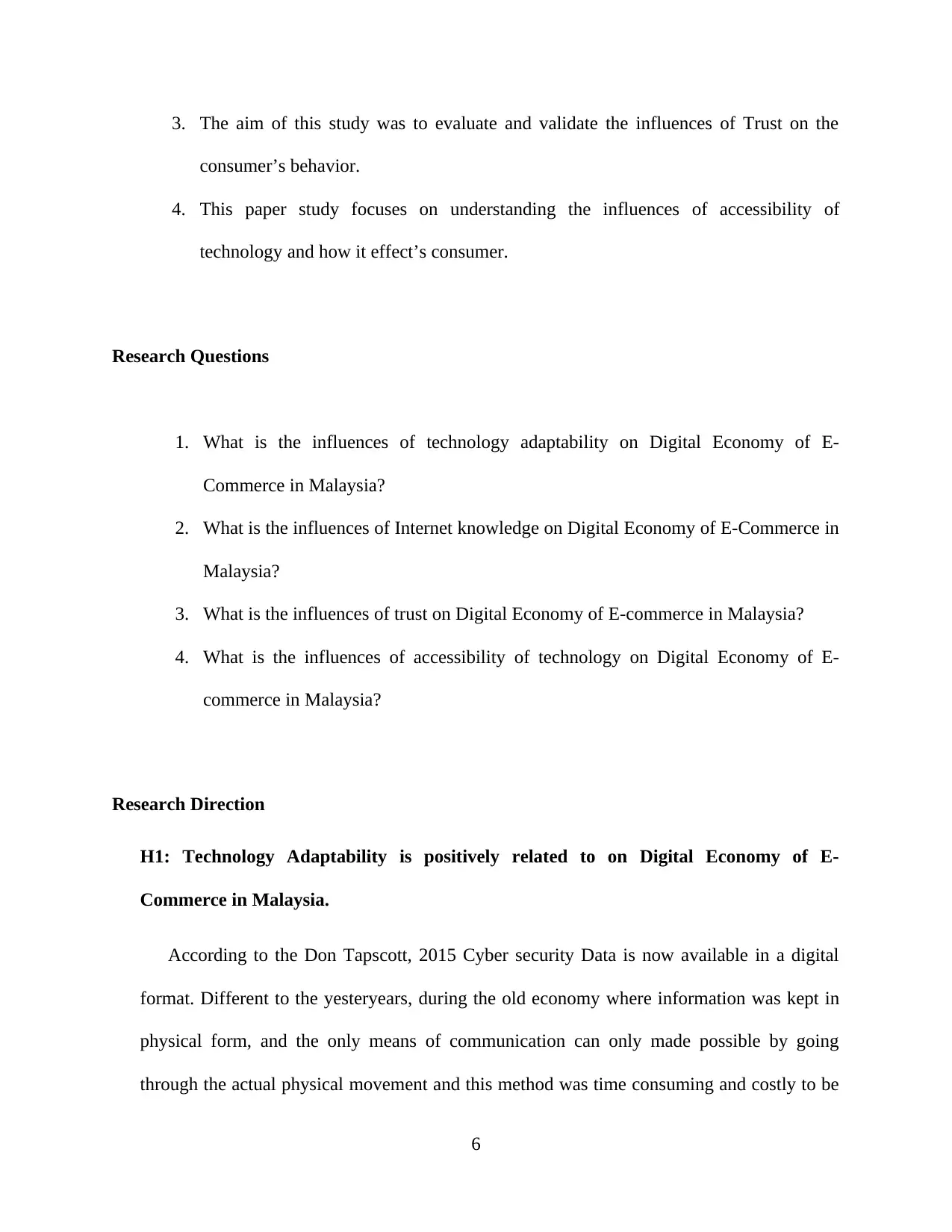
3. The aim of this study was to evaluate and validate the influences of Trust on the
consumer’s behavior.
4. This paper study focuses on understanding the influences of accessibility of
technology and how it effect’s consumer.
Research Questions
1. What is the influences of technology adaptability on Digital Economy of E-
Commerce in Malaysia?
2. What is the influences of Internet knowledge on Digital Economy of E-Commerce in
Malaysia?
3. What is the influences of trust on Digital Economy of E-commerce in Malaysia?
4. What is the influences of accessibility of technology on Digital Economy of E-
commerce in Malaysia?
Research Direction
H1: Technology Adaptability is positively related to on Digital Economy of E-
Commerce in Malaysia.
According to the Don Tapscott, 2015 Cyber security Data is now available in a digital
format. Different to the yesteryears, during the old economy where information was kept in
physical form, and the only means of communication can only made possible by going
through the actual physical movement and this method was time consuming and costly to be
6
consumer’s behavior.
4. This paper study focuses on understanding the influences of accessibility of
technology and how it effect’s consumer.
Research Questions
1. What is the influences of technology adaptability on Digital Economy of E-
Commerce in Malaysia?
2. What is the influences of Internet knowledge on Digital Economy of E-Commerce in
Malaysia?
3. What is the influences of trust on Digital Economy of E-commerce in Malaysia?
4. What is the influences of accessibility of technology on Digital Economy of E-
commerce in Malaysia?
Research Direction
H1: Technology Adaptability is positively related to on Digital Economy of E-
Commerce in Malaysia.
According to the Don Tapscott, 2015 Cyber security Data is now available in a digital
format. Different to the yesteryears, during the old economy where information was kept in
physical form, and the only means of communication can only made possible by going
through the actual physical movement and this method was time consuming and costly to be
6
⊘ This is a preview!⊘
Do you want full access?
Subscribe today to unlock all pages.

Trusted by 1+ million students worldwide
1 out of 102
Related Documents
Your All-in-One AI-Powered Toolkit for Academic Success.
+13062052269
info@desklib.com
Available 24*7 on WhatsApp / Email
![[object Object]](/_next/static/media/star-bottom.7253800d.svg)
Unlock your academic potential
Copyright © 2020–2025 A2Z Services. All Rights Reserved. Developed and managed by ZUCOL.



